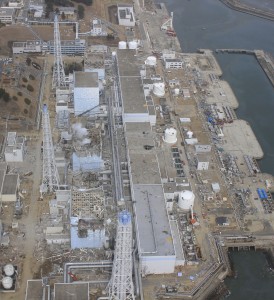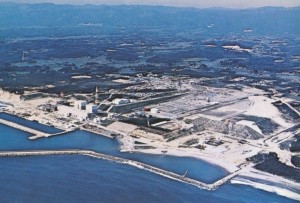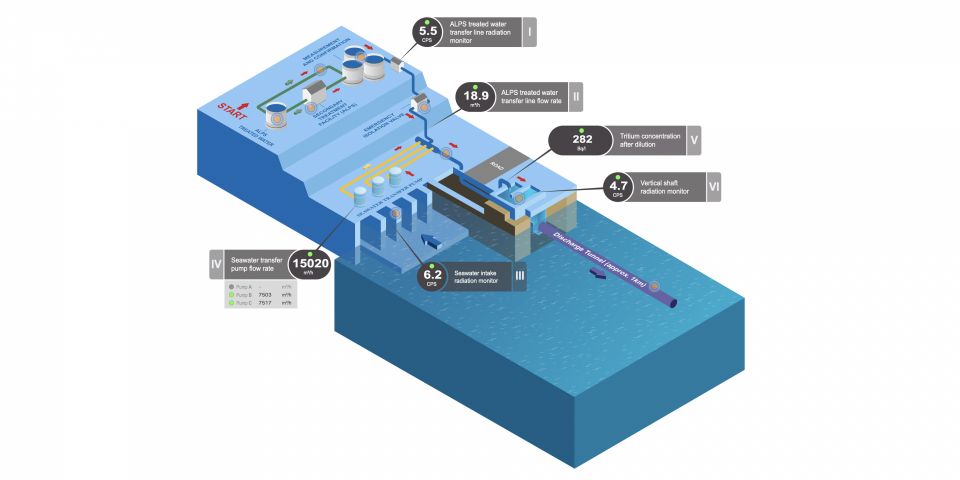Fukushima Two Years Later
At about a quarter to three in the afternoon on March 11, 2011, a gigantic and unprecedented earthquake struck just over 110 miles off the coast of Fukushima Prefecture in Japan. The quake was followed, just over 40 minutes later, by the first of several rounds of tsunami, which inundated enormous areas and eradicated entire towns and villages. Over 19,000 people were killed or are still missing, and over 6,000 survivors were injured.
Central to most narratives on this cataclysmic natural disaster has been the story of the Fukushima Daiichi nuclear accident. While no deaths have been attributed to the nuclear accident itself, or to radioactive contamination released from the plant, and while deaths at the Fukushima Daiichi nuclear site proper have been very few (three persons were killed on the day of the earthquake and tsunami-one by falling from a crane, two by drowning), the story of the nuclear accident continues to dominate press worldwide.
As we approach the two-year anniversary of these events, it's important to look back and ask some honest and direct questions about the nuclear accident and how it relates to us here in the United States. What do we know now that we didn't in the early days? Can we say for sure what was happening, both on a large and on a minute scale? Could the accident have been prevented? What are we doing to ensure something similar never happens again? What about the radiation exposure to the public? We will try to answer these and other important questions as we look back at two years' worth of study and analysis, recovery and cleanup, and planning and preparing.
(Above, Fukushima Daiichi nuclear power station under construction in 1971. To the left of the photo, Units 1 and 2 can be seen complete while Unit 3 is under construction; Unit 4 has not yet been started. Nearer the camera is the construction site for Units 5 and 6. Photo courtesy Will Davis collection.)
The Great Tohoku Earthquake and Tsunami ... and what we now know
As already described, the earthquake struck at 2:46 PM local time, and at that moment the three operating reactors at Fukushima Daiichi-Units 1, 2, and 3-detected the earthquake and were immediately shut down on a seismic scram signal. (The other units-4, 5, and 6-were shut down for maintenance.) Simultaneous with this event was a LOOP (loss of offsite power), caused by the electric distribution system outside the plant being damaged by the earthquake. At the Fukushima Daiichi station, the emergency diesel generators started as designed, and provided power to begin cooling down the three reactors that had been operating.
There has been speculation in some quarters that the earthquake caused damage to the plants and that this helped lead to the accident. In fact, all indications are that plant operations were nominal from the point of the seismic shutdown, LOOP event, and commencement of shutdown cooling at the three operating plants. As late as last November, presentations by the Tokyo Electric Power Company at the American Nuclear Society Winter Meeting revealed no suspicion of material failures at the plants prior to the tsunami's arrival, as corroborated by recorded plant parameters and operator statements.
Of course, the actual triggering event of the accident was the tsunami-derived inundation of the plant 40 minutes after the earthquake, which, because of the pressure of the violent inrush of water, caused more physical damage than an equivalent-depth slow flooding event. The tsunami flooded the plant because the protection was inadequate; the protection guarded against tsunami of nearly 20 feet while the actual event was almost 50 feet. It should be noted, though, that an unanticipated factor in the event was the fact that the coastline actually dropped several feet-thus negating a percentage of the tsunami protection.
The inundation of the plants meant that both the (mostly below ground) diesel generators and near-grade electric distribution equipment was rendered inoperable. This is the situation called SBO (station blackout), where no AC power is available at all. Generators were called for, and shipped from outside the plant, but the sheer damage to the site made bringing them in and moving them around exceedingly difficult. In addition, procedures for their use did not really exist. The total loss of AC power meant that only DC power, to operate some valves and instruments, was available-and even this was limited not only by the time until the batteries discharged, but also by damage as well. At that point, the plant was crippled by loss of power, serious physical damage, confusion on site due to communication problems (and continued aftershocks), and lack of solid emergency operating procedures in such events. This led to a loss of cooling for Units 1, 2, and 3 reactor cores, ultimately resulting in severe core damage. Failure of the containment function of the reactor buildings led to the release of radioactive material to the environment.
At the ANS 2012 Winter Meeting, Akira Kawano of TEPCO stated that spare seawater pumps (both portable pumps, and replacements for built-in or installed pumps destroyed by the tsunami), spare sources of electric power (of all three ranges-high voltage AC, low voltage AC, and DC-used at the plant) and spare pressure cylinders to allow operation of valves after loss of electric power would have been exceedingly helpful in the hours after the tsunami. TEPCO has gone far beyond provision of these items, though, in its plan for tsunami protection at nuclear plants in the future.
It is important to point out that Units 5 and 6 did not experience a long-term blackout because one of the above ground air-cooled diesel generators installed at that northern section of the site remained fully operable. This diesel was at Unit 6, but power was patched in from it to Unit 5 later. Air-cooled diesels did exist at the area of Units 1 through 4, but the destruction of the electric distribution network inside the plants by water coupled with the loss of fuel tanks rendered these useless. (In this case, "air cooled" means that the diesels used conventional radiators to dissipate waste heat to the air, unlike the large emergency diesel generators that required seawater systems to be operable in order to dissipate engine heat.)
Regarding this tsunami damage and its implications, TEPCO has addressed its future commitment to safety at its nuclear plants by designating three courses of action: First, it will take what it calls "Thorough Tsunami Countermeasures," which means large seawall protection, protection of buildings inside the seawall should the seawall be breached, and also provision of multiple backup power sources. Second of the triad is "Securing Functions by Adopting Flexible Countermeasures," by which it is meant that many varied backup power sources and sources of site assistance will be spread among many other sites. Finally, under "Mitigation of the Impact after Reactor Core Damage," TEPCO plans to make serious preparations to control events, even should the first two steps fail. This includes, but is not limited to, installation of hardened, filtered containment vents that can be operated remotely under even accident conditions. Click here to see a brief TEPCO synopsis of its accident analysis report that contains these three steps.
Eventually, all operators of nuclear plants in Japan will take serious measures like those described above, and more, to prepare the sites and personnel against future events like this. Some have already begun; click here to see a detailed account of preparations at two different sites in Japan. These efforts are enormous; Chubu Electric Power has stated that it will invest 140 billion yen (about US$1.47 billion) in its Hamaoka nuclear plant upgrades.
 At left, view of Fukushima Daiichi Units 1 through 4 after the accident. Photo courtesy Japanese Maritime Self Defense Force.
At left, view of Fukushima Daiichi Units 1 through 4 after the accident. Photo courtesy Japanese Maritime Self Defense Force.
Two of the reactor buildings at Fukushima Daiichi were severely damaged, and another partly damaged, by explosions of hydrogen gas that was generated by the damaged fuel while in contact with steam. This hydrogen got into the reactor buildings, built up in concentration, and later (quite famously, for both explosions were filmed from a distance) caused explosions in Unit 1 and Unit 3 reactor buildings. Evidence delivered by TEPCO at the ANS 2012 Winter Meeting now shows that the probable leakage point of the hydrogen into the primary containments and into the reactor buildings (after first getting out of the damaged reactor vessels) was through the drywell head flange at Unit 1, and also possibly at Unit 3. (Other papers delivered at that meeting hinted at other possible leak points; none can be assured until the plants are decommissioned.) Unit 4 experienced a hydrogen burn event as well; this is now known to have occurred because PCV (primary containment vessel) venting at Unit 3 allowed hydrogen to enter a common exhaust stack, and flow not only out the stack but into Unit 4's reactor building. Delayed and/or difficult venting of the containments is the key factor in this portion of the accident; venting would have prevented overpressurization of the primary containments, allowing them to retain physical integrity.
Containment vents have become a major topic of discussion after the accident. At the ANS Winter Meeting, Sang-Won Lee, a representative of Korea Hydro and Nuclear Power stated that all of its OPR1000 and APR1400 nuclear plants will have filtered containment vents installed by the year 2015 since KHNP considers this the "final means to prevent an uncontrolled release of radionuclides to the atmosphere." (Interestingly, all South Korean nuclear plants will fit or backfit seismic trip equipment as well.) Here in the United States, hardened vents, perhaps filtered, will eventually be fitted to all boiling water reactor plants with Mk I and Mk II containments; click here to see some detailed background on the decision-making process and on filtered vent systems at reactors in other countries. For more background on decision-making regarding filtered vents, click here.
Do we know all of the things that were going on at Fukushima Daiichi?
The answer to this question is a qualified "yes." In the time since the accident, many reports have been developed by TEPCO (and many other bodies) to attempt to explain the accident progression. As these reports came out, each subsequent report has benefited from more and better detailed information on the actual minute-to-minute actions being taken by operators on site, and from more detailed records that have been released. As of November 2012, when TEPCO made presentations on the accident at the ANS Winter Meeting, there were no new announcements made about operator actions, equipment failures, and records-and TEPCO representatives stated on several occasions that it is thought that the full range of operator actions is as well known now as it will ever be.
In terms of what was happening mechanically, we might say, throughout the accident, the truth is less certain. The loss of most of the plant instrumentation and the inability to access parts of the reactor buildings (even today) means that the exact progression of events once serious core damage began isn't known. It will not be known until the plants are more accessible (during defueling, years away) and not fully known until the plants are decommissioned and dismantled. It must be added that while these findings will eventually significantly add to our storehouse of knowledge, they're not essential to setting up procedures and equipment to prevent any such accidents in the future.
For such detailed reports as mentioned above, you can click here to see the Institute of Nuclear Power Operations report on the accident; you can click here to see a massive 500 page report on the accident by TEPCO; you can also find the American Nuclear Society's Fukushima Committee report here.
Could the Fukushima Daiichi accident have been prevented?
We could say "yes" at some, or many points along the way-for example, we might say (getting into details) that had the hydrogen explosion not occurred at Unit 1, there may not have been any serious core damage at the other units due to the site-wide problems caused by the Unit 1 hydrogen explosion. This is cherry picking, though; the best answer to the question is "yes, had the site been properly prepared for tsunami of the actual size experienced, and even if not, had it been prepared to respond both from inside the site and from outside to such a natural disaster." I've provided a link earlier to show what's being done in Japan to prevent such events; a clearly defined path for US nuclear plants to increase nuclear plant safety can be found in a document that the Nuclear Energy Institute calls "The Way Forward."
Our first modern wake-up call in the United States to such events was 9/11, in the sense that this experience was applied to nuclear plants here; after this, what are called "B.5.b" enhancements to US nuclear power stations saw the provision of numerous pieces of equipment to help combat site emergencies that included physical damage. Since the Fukushima Daiichi accident, much more has been developed. The industry response to the accident is called FLEX, and it provides essentially the same sort of mobile backup responses that the Japanese are beginning to implement (for stations that will restart.) The FLEX response is by now well known; you can click here to see details of its implementation and progress. There are also multiple documents available at NEI's Safety First website, found here.
So, the answer to "could this accident have been prevented" is "yes"-which means that future occurrences can also be prevented. The important provisions are spelled out clearly in the FLEX plans, and in those fairly duplicate plans being pursued by the Japanese: prevent loss of all AC power (station blackout) and prevent loss of the ultimate heat sink (where heat from the reactors and spent fuel is ultimately deposited, be it water or even the atmosphere) and prevent core damage.
What about the radiation dose received by citizens off site?
The World Health Organization has just released a report that tells us that the dose received by persons not on the site was actually not dangerous-in fact, according to WHO, most persons in Fukushima Prefecture received no more than 10 mSv, although some received as much as 50 mSv effective dose. You can read the entire report by clicking here.
This is not to say that the trauma experienced by those evacuated from the prefecture is not real; it is. It is important to understand that prevention of future events like the Fukushima Daiichi accident will also prevent massive evacuations of people from their homes. What it does mean is that exposure received by most people is far less than what they normally receive through the course of daily living and travel in a year. Click here to calculate your dose rate where you live in order to compare it to the figures in the WHO report.
The Fukushima Daiichi accident has been given the same INES scale rating as the Chernobyl accident-a rating of 7, or "Major Accident." This is because both accidents resulted in a release of radionuclides to the environment concurrent with reactor fuel damage. However, the release from Fukushima Daiichi was only about 10 percent that of Chernobyl; thus, the equivalent rating on the INES scale doesn't tell quite the whole story.
Where do we go from here?
In terms of the Fukushima Daiichi site, the planned decontamination and decommissioning of the whole site might take as long as 40 years, according to TEPCO's road map for site decommissioning. In the meantime, TEPCO will be performing a great deal of research on how to safely dismantle the nuclear plants, very likely with international cooperation.
Worldwide, each nation that either has nuclear plants or aspires to have them has made some hard decisions. In the case of a few, like Germany, the decision has been made to abandon nuclear plants entirely; Bulgaria recently decided not to build a nuclear plant, as well. In the cases of most nations, though, reviews and reports on 'lessons learned' from the Fukushima Daiichi accident have evolved into robust plans for action; this strategy applies to the United States, South Korea, and China as three of the foremost proponents of nuclear energy. Many other nations that did not have nuclear power prior to the accident but wished to have it are still on course to build nuclear plants; perhaps most well known of these is the effort underway in the United Arab Emirates. Many nations realize the need for electricity in order to have a more productive and safer society; in a number of cases, nuclear is the leading choice. (Also notable for entering into nuclear energy programs are Kenya, Vietnam, Turkey, and Kazakhstan.)
Indeed, it would seem that the greatly increased public dialogue and involvement after the accident on many varied aspects of nuclear energy (not just safety) has not led to widespread fear, shown by favorable poll numbers in the United States. Even as time goes on, the polls in favor of nuclear power hold up.
This has allowed the present-day general discussion about greenhouse gases and varied energy generating sources to, for the most part, include nuclear energy on an intelligent and rational basis. Much of that basis centers on the passive safety features of new nuclear plants such as the Westinghouse AP1000, which is designed to endure SBO events for 72 hours with no operator action whatsoever, and after that time and with some operator action to transfer water, can maintain core and containment cooling indefinitely. The reactor plant is also designed so that even in the event of a severe accident, the core will remain inside the reactor vessel-an important step in the prevention of release of radioactive material to the environment.
Nuclear plant operators and government regulators worldwide have responded to the Fukushima Daiichi accident with still-increasing vigilance, inspection, research, and action. It's clear that such an accident must never be allowed to happen again-and by the actions being taken at least in the United States, it would appear that we are well on our way to ensuring that we can meet any and every challenge that future severe events might bring, for the safety of both the plant operators and the citizens they serve.
______________________________________
 Will Davis is a consultant to, and writer for, the American Nuclear Society. In addition to this, he is a contributing author for Fuel Cycle Week, and also writes his own blog Atomic Power Review. Davis is a former US Navy Reactor Operator, qualified on S8G and S5W plants.
Will Davis is a consultant to, and writer for, the American Nuclear Society. In addition to this, he is a contributing author for Fuel Cycle Week, and also writes his own blog Atomic Power Review. Davis is a former US Navy Reactor Operator, qualified on S8G and S5W plants.






